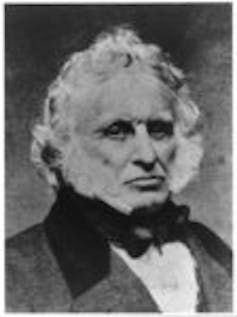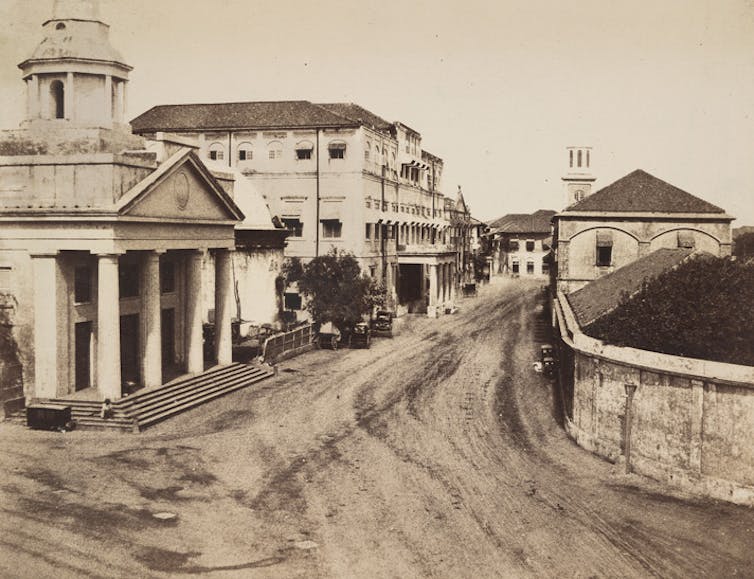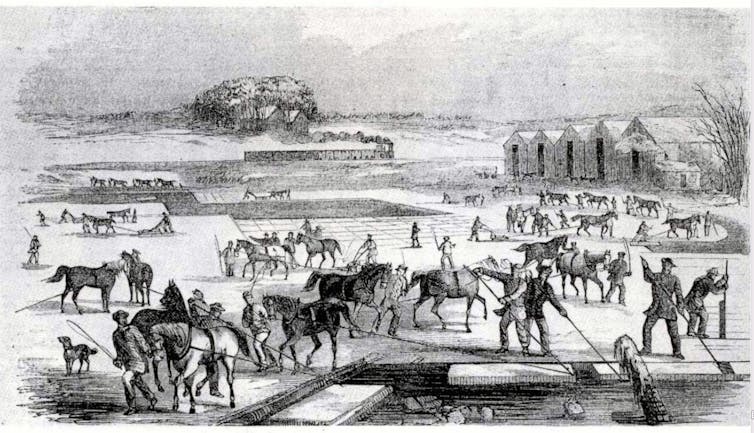
Tulasi Srinivas, Emerson College
If ever there was a year to toast drawing to an end, it’s 2020. Over the festive period, people around the world will be raising a glass to better times ahead.
Accompanying sighs of relief will likely be the subtle tinkling of ice.
In researching a book on the social, medical and moral history of gin and tonic, I have imbibed – moderately – in bars from the Raffles Hotel in Singapore to the Morse Bar in Oxford. At each venue, my G&T was always served over ice.
The history of chilled drinks goes back to antiquity. But it was the innovative “frozen water” trade from New England to India in the mid-19th century that popularized ice.
Frigid luxury
By that time, ice had been used to chill the drinks for millennia – but only ever for the elite.
Chilled wine was all the rage in first-century Rome. Ice chunks were brought down from the summits of Mounts Vesuvius and Etna to chill the food and drink of the wealthy. Roman author Pliny the Younger ascribes to Emperor Nero both the invention of the ice bucket and the chilling of water.
The Mughal emperor Humayun chilled summer fruit juice into a frozen sherbet in the mid-1500s. He used ice shavings from huge blocks of ice he transported on muleback from Kashmir to the capital city of Delhi. To keep it from melting, the ice was treated with potassium nitrate, otherwise known as saltpetre. By the 18th century the Mughals were so dependent upon ice for chilling both food and palaces that they built large “baraf khana,” or ice houses, to store the product.
Across the world in 17th-century Florence, the ruling Medici family would host elaborate feasts featuring tabletop mountain ranges sculpted from ice made by chilling water in winter. They also acted as patrons to Bernardo Buontalenti, the pioneer of modern-day ice cream.
But until the early 1800s, only emperors and the fabulously wealthy enjoyed the cooling effects of ice.
Cool customers
That changed with a young man from Boston. Frederic Tudor was born in 1783 to a wealthy Boston family who summered on a pond in Rockwood, just north of the city. There, they enjoyed ice cream and chilled drinks thanks to ice harvested in winter and stored in an ice house.

Library of Congress
When his brother, William, quipped that they should harvest ice from the estate’s pond and sell it in the tropics, Frederic took the notion seriously. He begged and borrowed from his social network, which included Revolutionary War heroes and merchant elite, to fund his ice enterprise.
According to Tudor’s diary, held at the Harvard Business School, he started shipping ice to the Caribbean island of Martinique in 1806. But islanders remained unconvinced of the benefits of chilling. The ice melted on the dock, and Tudor landed in debtors prison, owing over US$5,000 to his patrons.
Despite this setback, Tudor’s entrepreneurial spirit was said to be undimmed. By 1826 he had garnered enough business to hire noted inventor Nathaniel Jarvis Wyeth as foreman for his company – The Tudor Ice Co. Wyeth created new types of saws, pulleys, iron grids and hoisters needed for efficient ice harvesting. He cut huge blocks of ice from Fresh Pond in Cambridge using horse-drawn ice cutters, and moved them via rail to ships in the Boston and Salem harbors.
From there, the world awaited.
Ice houses of India
In 1833 Tudor was approached by Samuel Austin, a merchant of silks and spices, to ship ice to Calcutta, modern-day Kolkata, 16,000 miles away, as ballast to add weight to his empty ships. Austin knew that the colonial British in India were frightened of the tropical heat, believing it to be deadly, and they often escaped to the hills during the endless summer.
So on May 12, 1833, the ship Tuscany sailed from Boston for Calcutta, its hold filled with 180 tons of ice cut during the previous winter. When it arrived in Calcutta four months later, the ship still held 100 tons of ice. It meant Tudor could sell his superior ice at just 3 pence for a pound, undercutting his rivals who sold dirtier ice for much higher.
When news of the ice in Calcutta circulated, British merchants in Bombay, modern-day Mumbai, excitedly raised money to build an ice house in the city’s docks. Initially, demand was limited to the British and Parsis – Persians settled in India – but Tudor’s low prices and superior commodity soon ensured that most elite Indians had access to cold beverages through their homes, clubs and restaurants.

Wikimedia
Bombay’s ice trade with the U.S. was robust and continued through much of the 19th century, when, during the American Civil War, Indian cotton was used to fill the empty ice ships returning home.
By 1853 India became Tudor’s most lucrative destination, with Calcutta alone yielding an estimated $220,000 in profits.
A few of the structures built to accommodate the trade still exist today. A decade ago, I visited an ice house in Madras, modern-day Chennai – now known as Vivekananda House – an engineering marvel. British military engineer Col. J.J. Collingwood borrowed a Syrian roofing technique for the ice tower – a domed structure built using clay cylinders. This roof kept the ice very cool, as it was doubly insulated.
On Walden Pond
The American naturalist Henry David Thoreau noted the trade in the winter of 1846. After observing a crew of 100 ice cutters of the Tudor Ice Co. at work on Walden Pond, he wrote, “The sweltering inhabitants of Charleston and New Orleans, of Madras and Bombay and Calcutta, drink at my well.”

Wikimedia
It wasn’t just India. Ice cut in New England was transported to Singapore, Jamaica, Havana, New Orleans and Hong Kong.
As well as being able to deliver in bulk, Tudor also marketed the quality of his ice. His claim that the ice of Wenham Lake – 10 miles North of Boston – was the “purest” in the world spawned many imitators. In 1844, a competitor, The Wenham Lake Ice Co., opened an ice store in The Strand, London, where it displayed a large block of ice with a newspaper placed behind it so that passersby could read the print through the frozen water.
Ice King on the rocks
The Tudor Ice Co. flourished despite competition. In December 1847, The Sunbury American newspaper reported that 22,591 tons of ice were shipped to foreign ports.
In the space of 40 years, Tudor had built an ice empire, block by block, earning him the moniker the “Ice King.”
[Deep knowledge, daily. Sign up for The Conversation’s newsletter.]
But the icy winds of change were blowing. In 1844, the American inventor John Gorrie, a doctor who specialized in treating malaria – also related to the birth of the G&T – had produced a prototype of the modern air conditioner.
In 1851, Gorrie received a U.S. patent for one of the world’s first ice-making machines, and by 1860 he was successful in making ice through artificial refrigeration. Meantime, the New England lakes grew dirty with pollution from coal-fired railroads.
The Tudor Ice Co.‘s market declined precipitously; the company closed in 1887.
Tudor had died earlier in Boston, in the middle of winter, 1864. By that time, he had created what the ice industry now defines as “the clink effect” – the ability of ice cubes to recall a host of positive associations – around the world.![]()
Tulasi Srinivas, Professor of Anthropology, Religion and Transnational Studies, Institute for Liberal Arts and Interdisciplinary Studies, Emerson College
This article is republished from The Conversation under a Creative Commons license. Read the original article.




















